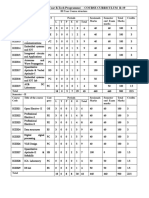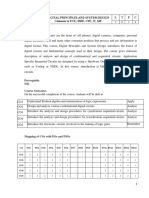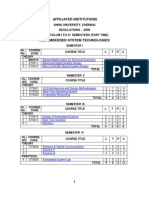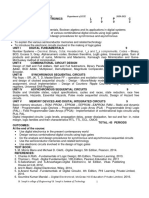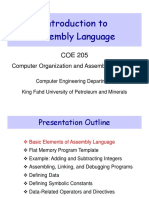LAB 1: Introduction To Verilog and Quartus II Design Software
Uploaded by
Azmeer KamarudinLAB 1: Introduction To Verilog and Quartus II Design Software
Uploaded by
Azmeer KamarudinEKT 303 – PRINCIPLES OF COMPUTER ARCHITECTURE
LAB 1: Introduction to Verilog and Quartus II design software
Student Name(s) Matrix No. Programme
1. Mohamad Azmeer Bin Kamarudin 171081317 RK53
2.
Task 1:
Mark Rubrics
DESIGN
4 Correct Verilog design with comments
3 Correct Verilog design without comment
2 Verilog design is partially correct
1 Totally wrong Verilog design
RESULT
3 Correct and neat presented waveform and RTL informative label.
2 Waveform and RTL partially correct or correct waveform and RTL but without label.
1 Waveform and RTL consist mistakes and badly presented.
DISSCUSIONS
5 Excellent and detail discussion by relate to design and result of each & every figures provided. Convincing
and smooth explanation
2 Simple discussion with acceptable explanation
1 The discussion did not provide any information related to the experiment. Poorly presented discussion.
Task 2:
Mark Rubrics
DESIGN
4 Correct Verilog design with comments
3 Correct Verilog design without comment
2 Verilog design is partially correct
1 Totally wrong Verilog design
RESULT
3 Correct and neat presented waveform and RTL informative label.
2 Waveform and RTL partially correct or correct waveform and RTL but without labelling.
1 Waveform and RTL consist mistakes and badly presented.
DISSCUSIONS
5 Excellent and detail discussion by relate to design and result of each & every figures provided. Convincing
and smooth explanation
2 Simple discussion with acceptable explanation
1 The discussion did not provide any information related to the experiment. Poorly presented discussion.
Penalty:
Mark Rubrics
0 Plagiarism
0 Late submission
SCHOOL OF COMPUTER AND COMMUNICATION ENGINEERING
Sem2-2018/2019
EKT 303 – PRINCIPLES OF COMPUTER ARCHITECTURE
TASK 1:
Full Adder:
a) Verilog of Full Adder:
b) Waveform of Full Adder:
c) Truth Table of Full Adder:
INPUTS OUTPUTS
X Y Cin Sum Cout
0 0 0 0 0
0 0 1 1 0
0 1 0 1 0
0 1 1 0 1
1 0 0 1 0
1 0 1 0 1
1 1 0 0 1
1 1 1 1 1
The waveform of the full adder that have been simulated in the Quartus II is correct since it
shows the same result as the truth table of the full adder
SCHOOL OF COMPUTER AND COMMUNICATION ENGINEERING
Sem2-2018/2019
EKT 303 – PRINCIPLES OF COMPUTER ARCHITECTURE
4-Bit Ripple Carry Adder:
a) Verilog of 4-Bit Ripple Carry Adder:
b) Waveform of 4-Bit Ripple Carry Adder:
c) Truth Table of 4-Bit Ripple Carry Adder:
X Y OUTPUTS
X3 X2 X1 X0 Y3 Y2 Y1 Y0 C S3 S2 S1 S0
0 0 0 0 0 0 0 0 0 0 0 0 0
0 1 0 0 0 1 0 0 0 1 0 0 0
1 0 0 0 1 0 0 0 1 0 0 0 0
1 0 1 0 1 0 1 0 1 0 1 0 0
1 1 0 0 1 1 0 0 1 1 0 0 0
1 1 1 0 1 1 1 0 1 1 1 0 0
1 1 1 1 1 1 1 1 1 1 1 1 0
The waveform of 4-bit ripple carry adder that have been simulated in the Quartus II is correct
since it shows the same result as the truth table of the 4-bit ripple carry adder. The truth table above was
obtained from the internet.
SCHOOL OF COMPUTER AND COMMUNICATION ENGINEERING
Sem2-2018/2019
EKT 303 – PRINCIPLES OF COMPUTER ARCHITECTURE
d) RTL of 4-Bit Ripple Carry Adder:
Sum and Cout of the Full Adder 1 is valid only after the propagation delay of Full Adder 1. In
the same way, Sum of the Full Adder 4 is valid only after the joint propagation delays of Full Adder 1
to Full Adder 4. Thus, the final result of the ripple carry adder is valid only after the joint propagation
delays of all full adder circuits inside it.
TASK 2:
4-Bit Adder/ Subtractor:
a) Verilog of 4-Bit Adder/Subtractor:
SCHOOL OF COMPUTER AND COMMUNICATION ENGINEERING
Sem2-2018/2019
EKT 303 – PRINCIPLES OF COMPUTER ARCHITECTURE
b) Waveform of 4-Bit Adder/Subtractor:
c) RTL of 4-Bit Adder/Subtractor:
The operations of both addition and subtraction can be performed by a one common binary
adder. Such binary circuit can be designed by adding an Ex-OR gate with each full adder. The figure
above shows the 4-bit binary adder/subtractor which has two 4 bit inputs as X3 X2 X1 X0 and Y3 Y2
Y1 Y0.
SCHOOL OF COMPUTER AND COMMUNICATION ENGINEERING
Sem2-2018/2019
You might also like
- BS 85742014 Code of Practice For The Management of Geotechnical DataNo ratings yetBS 85742014 Code of Practice For The Management of Geotechnical Data4 pages
- 4G-4G Traffic Sharing For LTC (Low Throughput Cells) Improvement in Huawei LTENo ratings yet4G-4G Traffic Sharing For LTC (Low Throughput Cells) Improvement in Huawei LTE3 pages
- Black & Decker The Complete Guide To Landscape Projects97% (34)Black & Decker The Complete Guide To Landscape Projects241 pages
- ECE - (4 Year B.Tech Programme) - COURSE CURRICULUM R-19No ratings yetECE - (4 Year B.Tech Programme) - COURSE CURRICULUM R-1918 pages
- 19EC303-DPSD - ECE-Updated 03.01.2020 PDFNo ratings yet19EC303-DPSD - ECE-Updated 03.01.2020 PDF4 pages
- MEBD Embedded Systems Scheme With Syllabus - 2011No ratings yetMEBD Embedded Systems Scheme With Syllabus - 201140 pages
- Regulations - 2009: Affiliated Institutions Anna University, ChennaiNo ratings yetRegulations - 2009: Affiliated Institutions Anna University, Chennai10 pages
- Computer Science and Engineering - 2024-25 OnwardsNo ratings yetComputer Science and Engineering - 2024-25 Onwards203 pages
- Instructions To Paper Setters: Maximum Marks: 75No ratings yetInstructions To Paper Setters: Maximum Marks: 756 pages
- CSE204_Digital Electronics (2023 Scheme)No ratings yetCSE204_Digital Electronics (2023 Scheme)4 pages
- M.E. Vlsi Design: Anna University of Technology Madurai MADURAI - 625002 Regulations 2010 Curriculam & SyllabiNo ratings yetM.E. Vlsi Design: Anna University of Technology Madurai MADURAI - 625002 Regulations 2010 Curriculam & Syllabi34 pages
- CO204 - Design of Digital Systems Lab (B. Tech, 3 Semester) : X y X yNo ratings yetCO204 - Design of Digital Systems Lab (B. Tech, 3 Semester) : X y X y4 pages
- Total: 45 Periods: Objectives: The Student Should Be Made ToNo ratings yetTotal: 45 Periods: Objectives: The Student Should Be Made To1 page
- Advanced Computer Architechture Lab Assignment 2 PDFNo ratings yetAdvanced Computer Architechture Lab Assignment 2 PDF5 pages
- Ect 203 Logic Circuit Design-Ece - s3 - 2019-Scheme-Syllabus - Ktustudents - inNo ratings yetEct 203 Logic Circuit Design-Ece - s3 - 2019-Scheme-Syllabus - Ktustudents - in11 pages
- Complement and R's Complement), Fixed Point RepresentationNo ratings yetComplement and R's Complement), Fixed Point Representation7 pages
- ECE1003_DIGITAL-LOGIC-DESIGN_ETH_1.1_3_ECE1003_revised (2)No ratings yetECE1003_DIGITAL-LOGIC-DESIGN_ETH_1.1_3_ECE1003_revised (2)2 pages
- Build Logic Gates with Universal NAND: CMOS and TTL in ActionFrom EverandBuild Logic Gates with Universal NAND: CMOS and TTL in ActionNo ratings yet
- Practical TTL Logic Gates: 74LS Integrated Circuits in ActionFrom EverandPractical TTL Logic Gates: 74LS Integrated Circuits in ActionNo ratings yet
- Build Switch and Logic Gates Using Transistors on the BreadboardFrom EverandBuild Switch and Logic Gates Using Transistors on the BreadboardNo ratings yet
- Digital Electronics 2: Sequential and Arithmetic Logic CircuitsFrom EverandDigital Electronics 2: Sequential and Arithmetic Logic Circuits5/5 (1)
- Solderless Breadboard Explorations: Unveiling the Wonders of Electronic PrototypingFrom EverandSolderless Breadboard Explorations: Unveiling the Wonders of Electronic PrototypingNo ratings yet
- RMAG Instruction Manual 1VAL255104-MB Rev DNo ratings yetRMAG Instruction Manual 1VAL255104-MB Rev D56 pages
- Autec: Safety Industrial Radio Remote ControlNo ratings yetAutec: Safety Industrial Radio Remote Control22 pages
- 80H1032350xA0 6G Dual Domain SAS Expander Daughter Board User Manual - 20120413No ratings yet80H1032350xA0 6G Dual Domain SAS Expander Daughter Board User Manual - 2012041315 pages
- 7230G分光光度计操作步序Spectrophotometer operation proceduresNo ratings yet7230G分光光度计操作步序Spectrophotometer operation procedures3 pages
- AS 1101.3-1987 Graphical Symbols For General Engineering - Welding and Non-Destructive ExaminationNo ratings yetAS 1101.3-1987 Graphical Symbols For General Engineering - Welding and Non-Destructive Examination85 pages
- Modified Atmosphere Packaging: Nazir Mir and Randolph M. Beaudry Michigan State University East Lansing, MichiganNo ratings yetModified Atmosphere Packaging: Nazir Mir and Randolph M. Beaudry Michigan State University East Lansing, Michigan10 pages
- Easa Airworthiness Directive: AD No.: 2011-0197No ratings yetEasa Airworthiness Directive: AD No.: 2011-01973 pages
- Hatchery Management Guide Simplified: Organized by DR/ Hesham KotbNo ratings yetHatchery Management Guide Simplified: Organized by DR/ Hesham Kotb105 pages
- BS 85742014 Code of Practice For The Management of Geotechnical DataBS 85742014 Code of Practice For The Management of Geotechnical Data
- 4G-4G Traffic Sharing For LTC (Low Throughput Cells) Improvement in Huawei LTE4G-4G Traffic Sharing For LTC (Low Throughput Cells) Improvement in Huawei LTE
- Black & Decker The Complete Guide To Landscape ProjectsBlack & Decker The Complete Guide To Landscape Projects
- ECE - (4 Year B.Tech Programme) - COURSE CURRICULUM R-19ECE - (4 Year B.Tech Programme) - COURSE CURRICULUM R-19
- Regulations - 2009: Affiliated Institutions Anna University, ChennaiRegulations - 2009: Affiliated Institutions Anna University, Chennai
- Computer Science and Engineering - 2024-25 OnwardsComputer Science and Engineering - 2024-25 Onwards
- M.E. Vlsi Design: Anna University of Technology Madurai MADURAI - 625002 Regulations 2010 Curriculam & SyllabiM.E. Vlsi Design: Anna University of Technology Madurai MADURAI - 625002 Regulations 2010 Curriculam & Syllabi
- CO204 - Design of Digital Systems Lab (B. Tech, 3 Semester) : X y X yCO204 - Design of Digital Systems Lab (B. Tech, 3 Semester) : X y X y
- Total: 45 Periods: Objectives: The Student Should Be Made ToTotal: 45 Periods: Objectives: The Student Should Be Made To
- Advanced Computer Architechture Lab Assignment 2 PDFAdvanced Computer Architechture Lab Assignment 2 PDF
- Ect 203 Logic Circuit Design-Ece - s3 - 2019-Scheme-Syllabus - Ktustudents - inEct 203 Logic Circuit Design-Ece - s3 - 2019-Scheme-Syllabus - Ktustudents - in
- Complement and R's Complement), Fixed Point RepresentationComplement and R's Complement), Fixed Point Representation
- ECE1003_DIGITAL-LOGIC-DESIGN_ETH_1.1_3_ECE1003_revised (2)ECE1003_DIGITAL-LOGIC-DESIGN_ETH_1.1_3_ECE1003_revised (2)
- Build Logic Gates with Universal NAND: CMOS and TTL in ActionFrom EverandBuild Logic Gates with Universal NAND: CMOS and TTL in Action
- Right Way to Build Half and Full Adders with Logic GatesFrom EverandRight Way to Build Half and Full Adders with Logic Gates
- Practical TTL Logic Gates: 74LS Integrated Circuits in ActionFrom EverandPractical TTL Logic Gates: 74LS Integrated Circuits in Action
- Build Switch and Logic Gates Using Transistors on the BreadboardFrom EverandBuild Switch and Logic Gates Using Transistors on the Breadboard
- Digital Electronics 2: Sequential and Arithmetic Logic CircuitsFrom EverandDigital Electronics 2: Sequential and Arithmetic Logic Circuits
- Solderless Breadboard Explorations: Unveiling the Wonders of Electronic PrototypingFrom EverandSolderless Breadboard Explorations: Unveiling the Wonders of Electronic Prototyping
- 80H1032350xA0 6G Dual Domain SAS Expander Daughter Board User Manual - 2012041380H1032350xA0 6G Dual Domain SAS Expander Daughter Board User Manual - 20120413
- 7230G分光光度计操作步序Spectrophotometer operation procedures7230G分光光度计操作步序Spectrophotometer operation procedures
- AS 1101.3-1987 Graphical Symbols For General Engineering - Welding and Non-Destructive ExaminationAS 1101.3-1987 Graphical Symbols For General Engineering - Welding and Non-Destructive Examination
- Modified Atmosphere Packaging: Nazir Mir and Randolph M. Beaudry Michigan State University East Lansing, MichiganModified Atmosphere Packaging: Nazir Mir and Randolph M. Beaudry Michigan State University East Lansing, Michigan
- Hatchery Management Guide Simplified: Organized by DR/ Hesham KotbHatchery Management Guide Simplified: Organized by DR/ Hesham Kotb









